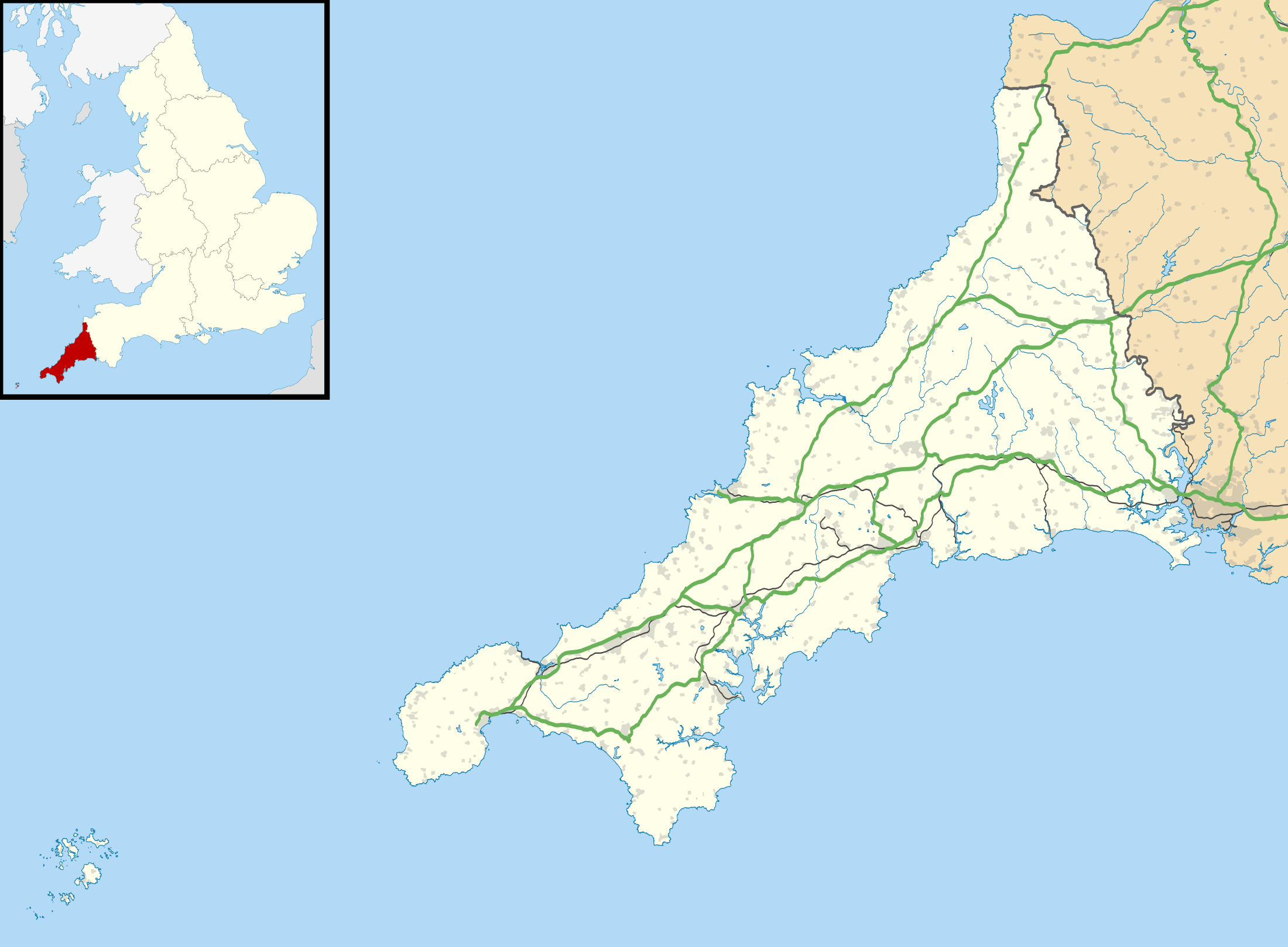All Saints' Church, Tuckingmill
All Saints’ Church, Tuckingmill is a Grade II listed parish church in the Church of England in Pendarves Street, Tuckingmill, Camborne, Cornwall.[3]
| All Saints’ Church, Tuckingmill | |
|---|---|
.jpg) All Saints’ Church, Tuckingmill | |
 All Saints’ Church, Tuckingmill Location within Cornwall | |
| 50°13′12.3″N 05°17′09″W | |
| Location | Tuckingmill, Camborne, Cornwall |
| Country | England |
| Denomination | Church of England |
| History | |
| Dedication | All Saints |
| Consecrated | 21 July 1845 |
| Architecture | |
| Heritage designation | Grade II listed[1] |
| Architect(s) | John Hayward of Exeter |
| Style | Norman Revival style |
| Groundbreaking | 31 August 1843 |
| Administration | |
| Parish | Camborne and Tuckingmill |
| Deanery | Carnmarth, North[2] |
| Archdeaconry | Cornwall |
| Diocese | Truro |
| Province | Canterbury |
History
The foundation stone for the new church was laid with the following inscription
The foundation stone of this Church, dedicated to All Saints, was laid to the Glory of God and for the Salvation of Man, by the Rt. Hon. the Baroness Basset of Tehidy, on 31st day of August 1843.[4]
The parish church of All Saints was built in the Norman Revival style, with the north aisle having a heavy granite arcade. The architect was John Hayward of Exeter. The Norman font came from the chapel at Menadarva.[5] It was consecrated by the Lord Bishop of Exeter on 21 July 1845.[6]
The church was renovated in 1875–79 by Piers St Aubyn with the raising and tiling of the chancel, removing the tower gallery, replacing the seats and repairing the walls and windows. The contractor was Mr. W. May of Pool.[7]
A reredos with an ″Irish serpentine″ border, inlaid with marble and also designed by Mr Piers St Aubyn was completed in November 1882.[8] The cross is made of alabaster.[9] The church was re-opened on Thursday, 20 February 1879.[10]
Parish status
The church is in a joint benefice with:
- St Martin and St Meriadoc’s Church, Camborne
- Holy Trinity Church, Penponds
Stained glass
The east window dates from 1847 and was designed by Joseph Bell. The rest of the stained glass is from the 1890s by Fouracre and Watson or Fouracre and Son of Plymouth.
Organ
A new organ, costing £120 (equivalent to £12,300 in 2019),[11] of nine speaking stops was purchased from Hele and Sons of Plymouth in 1879. A specification of the organ can be found in the National Pipe Organ Register.[12]
Bells
The peal of eight bells in the tower comprises 8 by John Taylor and Company. Originally installed as a ring of 6 in 1931, the ring was expanded with the addition of two bells in 1936.[13]
References
- Historic England. "Church of All Saints (Grade II) (1310848)". National Heritage List for England. Retrieved 11 May 2019.
- "Tuckingmill, All Saints". A Church Near You. The Church of England. Retrieved 11 May 2019.
- Beacham, Peter; Pevsner, Nikolaus (2014). The Buildings of England. Cornwall. Yale University Press. p. 686. ISBN 9780300126686.
- "New Church at Tuckingmill". Royal Cornwall Gazette. England. 8 September 1843. Retrieved 11 May 2019 – via British Newspaper Archive.
- Pevsner, N (1970) Cornwall; 2nd ed., revised by E Radcliffe. Harmondsworth: Penguin; p. 236
- "The Church". Statesman and Dublin Christian Record. England. 29 July 1834. Retrieved 11 May 2019 – via British Newspaper Archive.
- "Church Restoration at Tuckingmill". The Cornish Telegraph. England. 25 February 1879. Retrieved 11 May 2019 – via British Newspaper Archive.
- "A Very handsome reredos". The Cornishman (240). 15 February 1883. p. 7.
- "Penzance". The Cornishman (229). 30 November 1882. p. 4.
- "Roskear Church". The Cornishman (33). 27 February 1879. p. 5.
- UK Retail Price Index inflation figures are based on data from Clark, Gregory (2017). "The Annual RPI and Average Earnings for Britain, 1209 to Present (New Series)". MeasuringWorth. Retrieved 2 February 2020.
- "NPOR N11302". National Pipe Organ Register. British Institute of Organ Studies. Retrieved 11 May 2019.
- "Tuckingmill, Cornwall All Saints". Dove's Guide for Church Bell Ringers. Dovemaster. 18 August 2009. Retrieved 11 May 2019.